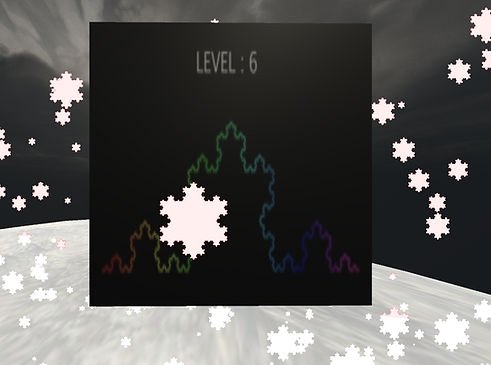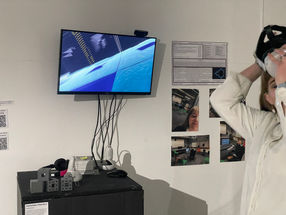Featuring: Fractals
FINAL MAJOR PROJECT & THESIS
The showcase / advertisement trailer for Featuring: Fractals

All Videos
Featuring: Fractals is an installation that contains an exploratory project used to display fractals. Fractal scenes are explored and interacted with using gamification unique to VR.
My goal is to push forward the progression of which the user experiences fractals in unique ways via wearable technology and educate people on the beautiful nature of fractals: geometric, natural
It is my goal to pioneer wearable technologies that enable users to experience fractals in unique ways and to educate them about the beauty of fractals: geometric, natural, and ethereal.
The aspect of Virtual Reality as a wearable, immersive tool, has incalculable potential to give artists and game developers unlimited ways to express themselves creatively inside a 3D space. In this project, the user will experience and interact with a variety of fractals in a 3D space using immersive mechanics such as climbing, picking up objects, and shooting bows and arrows.

Degree Show
Above you can see photos from my degree show. I conducted testing and video captures of these people while playing.
Thank you to all who participated in my experience.
Special thanks to my tutors: Despoina, ana, Zhan and Herman
Thesis
This play testing was conducted prior to me showing it to the public for the first time at my degree show.
The Mandelbrot Set
The Mandelbrot fractal is a famous mathematical object that is named after the mathematician Benoit Mandelbrot. It is created by iterating a complex mathematical function over a set of complex numbers. The resulting pattern is a set of points in the complex plane, where the points that remain bounded under the iteration of the function are part of the fractal. The Mandelbrot fractal is known for its intricate and infinitely complex structure, which has been studied extensively in the field of mathematics. It is also widely used in computer graphics and other applications.
I created in unity the Mandelbrot set and this is the code that I used to make the shader.

Shader display
Variables can be adjusted within Unity
I used WASD keys to interact with the Mandelbrot set first as a 2D fractal

This is a demo that I created of the fractal generator mechanic - the demo shows different generations I am inputting into the code and how it changes the appearance.
In the video below you can see my final layout of the main hub, which is generated to be a 3rd iteration, Menger Sponge fractal.

The Menger Sponge:
I used this fractal to create my main hub/respawn area.
Watch = respawn tool
Gameplay
My colleague (Sam MA Games Design) demoing my most used physics interaction, climbing.
Hurricane VR Physics Interaction Toolkit
I used this physics toolkit to set up my VR rig, locomotion, and interactions.
I explored different ways of featuring fractals in my game, this demo was one of the early ideas I had of using 3D fractals to reflect the skybox.
3D Fractals

Koch Snowflake
The Koch snowflake is a unique fractal because it is created by starting with a triangle and then adding smaller triangles to the middle of each side. This process is repeated indefinitely, resulting in a shape that has an infinitely complex boundary and a finite area. The Koch snowflake is also interesting because it is self-similar, meaning that a smaller version of the snowflake can be found within the larger one.



Pythagoras Tree

The Pythagoras tree is a fractal that is created using the Pythagorean theorem to generate a series of squares that are arranged in a specific way. The fractal is created by starting with a square and then adding two smaller squares to the sides of the original square. The sides of the new squares are perpendicular to the sides of the original square, and the length of the sides of the new squares is determined by the Pythagorean theorem. This process is then repeated indefinitely, resulting in a tree-like structure with branches that get smaller and smaller as they get further from the center. The Pythagoras tree is named after the famous Greek mathematician Pythagoras, who is known for his work on geometry, including the theorem that bears his name.


Pythagoras was a famous Greek mathematician known for his work on geometry, including the famous theorem that bears his name. This theorem states that in a right triangle, the square of the length of the hypotenuse (the side opposite the right angle) is equal to the sum of the squares of the lengths of the other two sides. It is not clear how this theorem would be related to a fractal.
Menger Sponge


Romanesco Broccoli
A variant of cauliflower, is the ultimate fractal vegetable. Its pattern is a natural representation of the Fibonacci or golden spiral, a logarithmic spiral where every quarter turn is farther from the origin by a factor of phi, the golden ratio. The Fibonacci sequence, a common and beautiful numeric pattern in nature, creates the Golden Ratio.


I used the code above combined with this Mukbang to include an "eating" Mechanic in my project to have the VR experience.


The Pentagram
The pentagram is more famous as a magical or holy symbol. It has the Golden Ratio in it:
-
a/b = 1.618…
-
b/c = 1.618…
-
c/d = 1.618…
Chaos Theory
“Chaos is the science of surprises, of the nonlinear and the unpredictable.” (Fractalfoundation.org, 2018).
Chaos theory teaches us to expect the unexpected. Chaos theory approaches nonlinear concepts or situations that are adequately uncontrollable or predictable. Examples of chaos theory include; weather, turbulence, the stock market, our brain state, etc. Fractal mathematics is often used to describe these phenomena and capture the infinite complexity which is found in nature.
“Many natural objects exhibit fractal properties, including landscapes, clouds, trees, organs, rivers, etc, and many of the systems in which we live exhibit complex, chaotic behavior “ (Fractalfoundation.org, 2018).
The theme of my project will be Chaos Theory in the sense that the scenes are connected in a way that is not connected and unexpected and the user will be able to explore these scenes while learning about fractals (2D, 3D, Natural, and geometric).
Coastline Paradox


I used a button with text to voice and brought the educational part of my game into action.
Archery Scene
I used this archery scene to demonstrate fractal iterations using a fun mechanic (bow and arrow).

13 iterations of the Pythagorean triangle.

Pythagorean tree animation
Early ideas of shooting immortal dragons and spawning fractal animation.
Infinity
The concept of infinity refers to the idea of something that has no end or limit. It is often used to describe things that are infinitely large, infinitely small, or infinitely complex. For example, the universe is considered to be infinitely large, as it is believed to be constantly expanding and never-ending. The concept of infinity is also used to describe things that are infinitely small, such as the particles that make up atoms, or the infinitely complex patterns that can be found in nature.
In mathematics, infinity is represented by the symbol ∞, and it is used in a variety of contexts. For example, it is used to represent the result of dividing a number by zero, or the limit of a function as the input value approaches infinity. Despite its widespread use, the concept of infinity remains a topic of debate and disagreement among philosophers and mathematicians. Some people argue that infinity is a real and meaningful concept, while others argue that it is a meaningless or impossible concept.
Appendix
Social VR –
Museum of other Realities and VRChat
Museum of Other Realities is one of the chosen case studies for my thesis.

All Videos















































